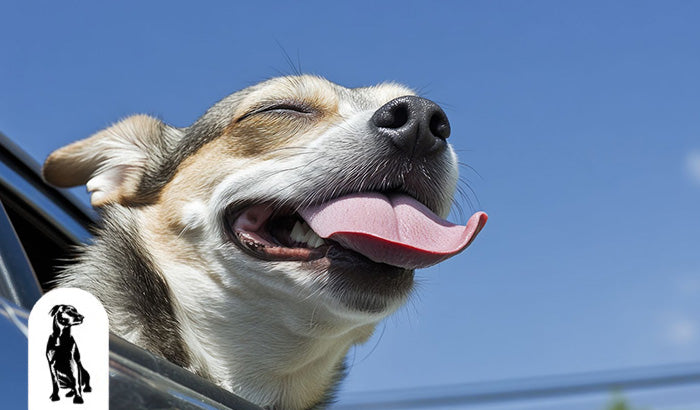
Road trips with your dog offer the perfect opportunity to explore new places, soak in scenic views, and enjoy quality time with your dog by your side. Whether you’re heading to the mountains, cruising along the coast, or visiting family across the country, bringing your furry companion adds an extra layer of fun and companionship to the adventure.
Traveling with your dog creates unforgettable memories but also comes with unique challenges. From car safety to potty breaks, pets require a little extra planning to stay healthy, happy, and stress-free throughout the journey. A spontaneous approach may work for solo travelers, but when your pup is along for the ride, preparation makes all the difference.
This guide will walk you through the top things dog owners often overlook on the road and how to stay ahead of them for a successful, tail-wagging trip.
Skipping a vet check before the trip
A road trip involves making sure your dog is healthy and ready for travel. A pre-trip vet visit should be scheduled to update essential vaccinations like rabies, Bordetella, and leptospirosis. Health certificates may be required if state lines are crossed or boarding is planned. Prescription refills for ongoing medications such as heartworm preventatives should be completed.
If motion sickness or anxiety is a concern, short-term treatments may be suggested. A quick checkup provides peace of mind, ensures protection against common travel risks, and helps make the journey safer and more comfortable for everyone.
Forgetting essential gear and supplies
Smart packing supports smooth traveling with your dog. Food, water, and bowls should be included, with collapsible options preferred for convenience. A leash, harness, and waste bags are considered must-haves. Comfort is improved with familiar toys and a blanket or bed.
A pet first-aid kit stocked with bandages, antiseptic wipes, tweezers, and necessary medications is recommended. Seat covers or crates provide protection for car interiors and secure space for the dog during travel. Without these essentials, stress and discomfort are more likely to occur on the road.
Letting your dog roam freely in the car

Unrestrained dogs in vehicles create serious safety concerns. If a pet is thrown forward during sudden stops or turns, it may cause injury. Distractions are also caused when dogs move into the driver’s space or interfere with controls. Securing dogs with travel harnesses, booster seats, or crash-tested crates improves safety.
Small breeds benefit from booster seats that provide both elevation and restraint. Crates offer added comfort for dogs that prefer enclosed spaces. Proper restraint ensures safer travel and reduces stress for both the pet and the driver.
Not planning pet-friendly stops
Skipping breaks during a road trip can lead to restlessness, stress, or even illness for dogs. Like people, they need time to stretch, hydrate, and use the bathroom. Without these opportunities, long rides become uncomfortable.
Breaks every two to three hours help maintain physical comfort and reduce anxiety. Dog-friendly rest areas, parks, or shaded trails offer great spots for quick outings. Planning ahead with apps like BringFido or GoPetFriendly ensures access to clean, safe locations where pets can relax. Regular stops support both your dog’s well-being and a smoother travel experience.
Ignoring the weather forecast
Disregarding weather conditions can lead to dangerous situations during road trips with your dog. Inside a parked car, temperatures climb or drop much faster than expected. Even mild weather can cause overheating or chilling in minutes, especially for small or short-haired breeds. Travel safety depends on monitoring forecasts before and throughout the trip.
Air conditioning, extra blankets, and limited exposure to extreme heat or cold can help manage your dog’s comfort. Activities should be planned during cooler hours, and indoor attractions used when conditions become harsh. By staying prepared, pets are kept safe, relaxed, and ready to enjoy the ride.
Overfeeding before or during the drive
Feeding a large meal right before travel often leads to motion sickness or stomach upset. Dogs may drool, whine, pace, or vomit when they feel nauseous, turning the ride into an unpleasant experience. A light meal served a few hours before departure allows for easier digestion. During the trip, large meals should be avoided.
Instead, small treats offered at breaks help maintain energy without overwhelming the stomach. Hydration remains important, but water should be given in small amounts. Using spill-proof, portable bowls makes it easy to keep your dog comfortable and nourished throughout the journey.
Leaving your dog unattended
Leaving a dog alone in a parked car places them at serious risk. Interior temperatures rise rapidly in warm weather and plummet in the cold, even with windows cracked. These extreme conditions lead to heatstroke or hypothermia in minutes.
Many states also prohibit leaving pets unattended in vehicles, and violations may bring legal consequences or emergency interventions. Travel plans should include pet-safe options. Share break duties with travel companions or choose drive-throughs, pet-friendly businesses, or curbside services when alone.
Protecting your dog’s safety ensures a smoother, safer trip for everyone.
Skimping on ID tags and microchips
Accidents happen, and even the most well-behaved dogs can slip out of a collar or dash from a car door. When traveling, your dog faces unfamiliar environments, new smells, and unexpected distractions, all of which increase the risk of them getting lost. That’s why clear, accurate identification matters more than ever on the road.
Make sure your dog wears a secure collar with an up-to-date ID tag that includes your current phone number. Before hitting the road, double-check that their microchip registration matches your most recent contact information. Microchips offer a permanent form of identification, but they only work if the details are accurate and accessible through the registration database.
For added peace of mind, consider attaching a temporary travel tag that includes your destination address, hotel name, or alternate phone number. This small step gives anyone who finds your dog a faster way to return them safely.
Preparedness can make all the difference. With proper ID and a registered microchip, you give your dog the best chance of a quick and safe reunion if they wander off during your journey.
Failing to maintain a routine
Dogs thrive on consistency. A sudden change in their daily rhythm can lead to stress, restlessness, or even digestive issues. While road trips with your dog often bring new sights and adventures, keeping your dog’s basic routine intact helps them feel grounded and secure.
Stick to their usual meal schedule whenever possible. Feed your dog at the same times they eat at home, even if you’re stopping at a rest area or staying in a hotel. Regular feeding keeps their digestion steady and reduces anxiety caused by unpredictability.
Try to maintain their typical walking and bathroom breaks. Whether your dog is used to a morning walk, a midday outing, or a bedtime potty break, honoring those habits keeps them calm and comfortable. Familiar timing makes unfamiliar places feel less overwhelming.
Sleep also plays a big role in your pet’s mood and health. Create a consistent bedtime routine by bringing along their favorite blanket or bed. Let them wind down the same way they would at home, whether it’s with a toy, a quiet cuddle, or a short walk.
Not preparing for emergencies
Unexpected events often disrupt even the most organized road trips. Illness, injury, or a missing pet may occur without warning. A plan should be in place before departure. Emergency vet clinics along the route can be located in advance. Contact information should be saved digitally and stored as a printed backup. Clinics near overnight stays offer the most convenience.
A pet-specific first-aid kit should be packed with gauze, antiseptic wipes, tweezers, and any necessary medications. Medical records and vaccination details should be kept in both digital and printed formats. A recent photo of your dog on your phone helps in case of separation. GPS collars may be used for added safety.

Travel smarter with Plush Paws by your side
Successful traveling with your dog begins with preparation and awareness. By avoiding common mistakes — from skipping vet visits to forgetting safety restraints — you set the stage for a smoother, safer adventure for both you and your pup. Thoughtful planning keeps your dog healthy, relaxed, and ready to enjoy the journey.
For added peace of mind, shop Plush Paws to support your travels. Our premium pet seat covers, harnesses, and travel accessories protect your vehicle and keep your pet comfortable every mile of the way. Whether you're heading across the state or across the country, Plush Paws makes every trip better.
